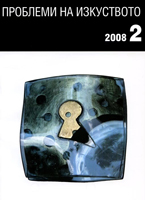Историческо развитие и приложение на фотомеханичните способи в съвременното графично изкуство
The Historical Development and Application of Photomechanical Techniques in Modern Graphic Art
Author(s): Desislava Hristova-ToshevaSubject(s): Cultural history
Published by: Институт за изследване на изкуствата, Българска академия на науките
Summary/Abstract: This work defends the viewpoint that termi The development of photomechanical processes is linked to the discovery of photography and the search for ways to reproduce photographic images using printed means. During the 1850s many experimental photomechanical processes arose, stemming from heliography and daguerrotypes. This article examines the most important of them, which contributed to the development of photogravure, photolithography, collotypes and photo-zincography. Photogravure: the processes used by Docteur Donne, Hippolyte Louis Fizeau, Edouard Baldus, Alphonse Poitevin, Paul Pretsch and Charles Negre are examined, as well as the essential photogravure process presented by Talbot in 1852 under the name photoglyphic engraving, which was perfected by Karel Klic in 1879. The method is also known by the name aquatint photogravure or the Talbot-Klic process. Contemporary ways of processing photogravure are also examined. Photo lithography: Since Poitevin ‘s patenting of the photolithography process in 1855 until the present day the process has not essentially changed. One graphic studio well-equipped for photolithography is the Bulgarian Artists’ Union (BAU) lithographic studio. The photosensitive emulsion with which the stone is sensitized was hand-crafted by the master lithographer Viktor Kirilov. A recipe and directions for the processing of the emulsion is included. Collotypes: The appearance, perfection and special characteristics of collotypes are examined. This technique is one of the most attractive non-screen printing processb - all halftones and details of the original are printed onto the paper through finely grained gelatin. Collotype printing can be used in lithographic studios as an alternative printing method. The method for processing a collotype plate is described. Photo-zincography: Today photo-zincography has been replaced by flexoprinting technology based on photopolymeric materials. In recent years, photopolymeric emulsion has been gaining popularity among graphic artists, printers and photographers. One of them is the artist and master printer Dan Welden, who in the 1970s experimented with photopolymeric plates for relief printing and invented Solarplates. Various institutions, master printers and artists are involved in the search for alternative methods for printing based on photo mechanical technology from the recent past and nontoxic printing processes; the most important such actors are noted. Some have discovered entirely new methods, while others are based on processes from the past that have been transformed for modern use.
Journal: Проблеми на изкуството
- Issue Year: 2008
- Issue No: 2
- Page Range: 42-48
- Page Count: 7
- Content File-PDF

